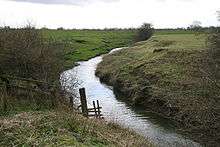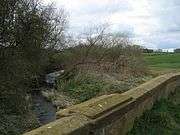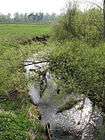River Wiske
| River Wiske | |
|---|---|
 River Wiske close to its confluence with the River Swale | |
| Country | England |
| Basin | |
| Main source |
Confluence of Stony Lane Beck and Carr Beck nr Ingleby Arncliffe 69 metres (226 ft) 54°23′10″N 1°19′25″W / 54.38611°N 1.32361°W |
| River mouth |
River Swale nr Kirby Wiske 21 metres (69 ft) 54°14′38″N 1°26′19″W / 54.24389°N 1.43861°WCoordinates: 54°14′38″N 1°26′19″W / 54.24389°N 1.43861°W |
| Basin size | 215.5 square kilometres (83.2 sq mi) |
| Physical characteristics | |
| Length | 46.9 kilometres (29.1 mi) |
The River Wiske is a river in the county of Yorkshire, England and is a tributary of the River Swale. The Wiske gives its name to several of the villages it passes through. The name Wiske is derived from an Old English word wisca meaning a water meadow.[1]
The river is maintained by the River Wiske Internal Drainage Board, which is part of the Shires Group of IDBs.[2] It lies within the national character areas (NCAs) of the Vale of Mowbray and the Tees Lowlands.
Course
The river becomes the Wiske at the confluence of Carr Beck and Stony Lane Beck south of the village of Ingleby Arncliffe close to the Tontine Bridge where the A19 and A172 roads diverge. It flows north in a series of meanders as far as East Rounton where it turns north-westerly and then westerly past Appleton Wiske. The river continues to flow westerly until just after passing under the A167 road near Great Smeaton where it turns south. It follows a mainly southerly direction towards Danby Wiske, Yafforth, and Northallerton. The river then alternates between a southerly and south-south-easterly direction until Kirby Wiske, where it turns south-west to join the River Swale. Water from the river eventually enters the sea at Spurn Head at the mouth of the River Humber.
During the drought of 1995/96 Yorkshire Water installed a pipeline connecting the River Tees near Darlington to the river near Birkby, south of Great Smeaton. This link enables water to be transferred from the Tyne and Wear into the Tees and thence to the Wiske for pumping out from the River Ouse at York. Although the pipeline was never used it was tested and remains as an "insurance policy". There are ongoing concerns about the biological impact of mixing water in Yorkshire's rivers.
Geology
The River Wiske is underlain by a range of geological deposits, including undifferentiated sandstone, conglomerate, undifferentiated mudstone, siltstone and sandstone from the Triassic period, and the Lias group consisting of mudstone, siltstone, limestone and sandstone from the Mesozoic period.[3]
Natural history
There are four areas of non-statutory Nature Conservation Sites along the river, Middlebrough plantation just outside Newby Wiske; Stony Lane Pond near the confluence of Stony Lane Beck and Carr Beck; Pepper Arden Bottoms near East Cowton and Pheasantry Wood and Fox Covert near Danby Wiske.[3]
The river passes through farmland bounded by hedgerows with some wet woodland near Kirby Wiske and some grassland near Newby Wiske.[3] Biodiversity audits carried out in 2010 found European water vole on the river between Danby Wiske and Brompton Beck. European otters were found on the river between North Otterington and Kirby Wiske. Soprano pipistrelle and brown long-eared bat were also found in the area along with kingfisher, reed bunting and lapwing.[3]
Lists
Tributaries
|
Settlements |
Crossings
|
Gallery
| River Wiske Images | ||||||||||
|---|---|---|---|---|---|---|---|---|---|---|
|
Sources
References
- ↑ Ekwall, Eilert, The Concise Oxford Dictionary of English Place Names, Oxford (1960)
- ↑ "Management". Retrieved 21 August 2011.
- 1 2 3 4 "Geology of River Wiske" (PDF). Retrieved 21 August 2011.
| Wikimedia Commons has media related to River Wiske. |




